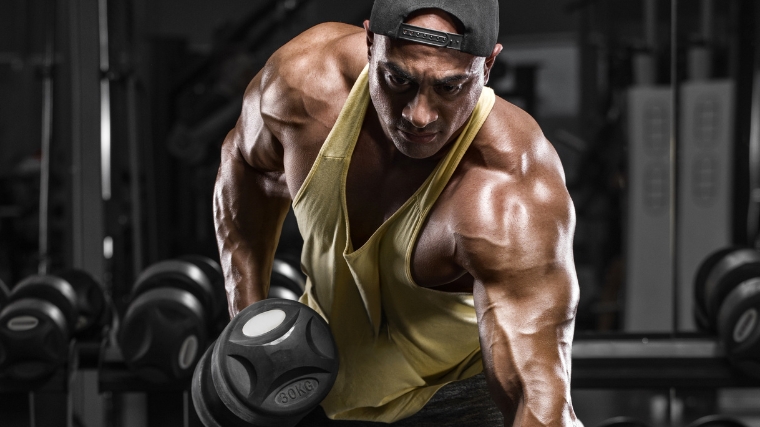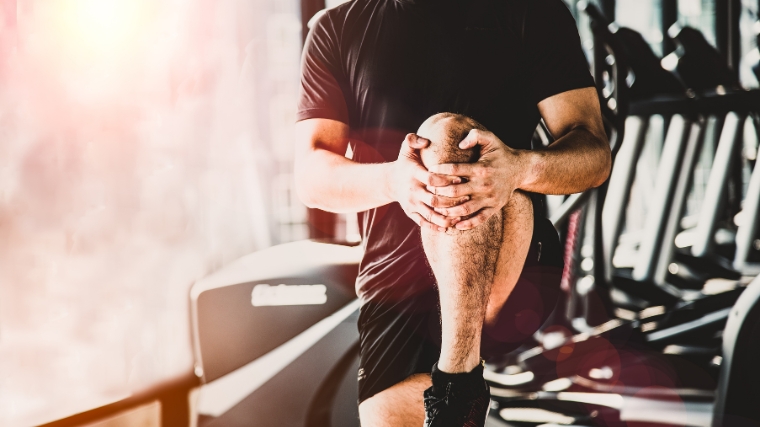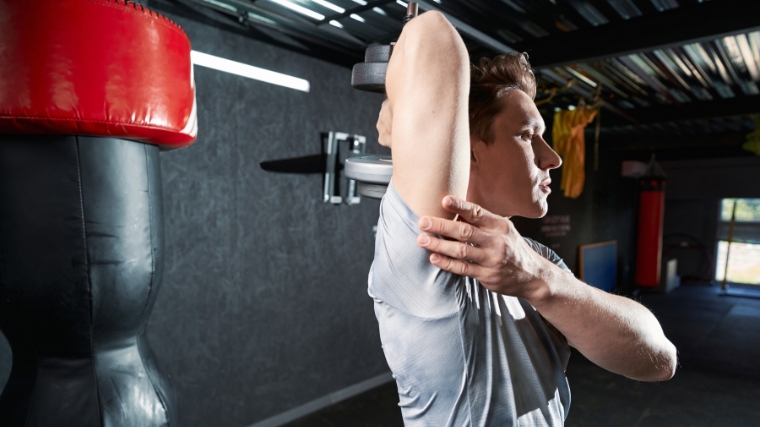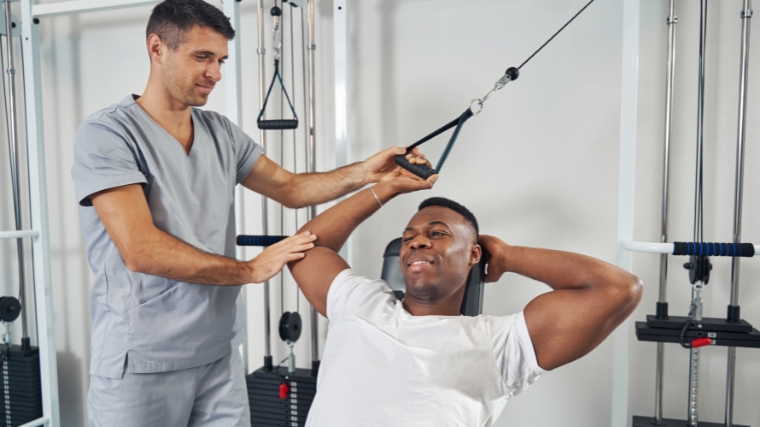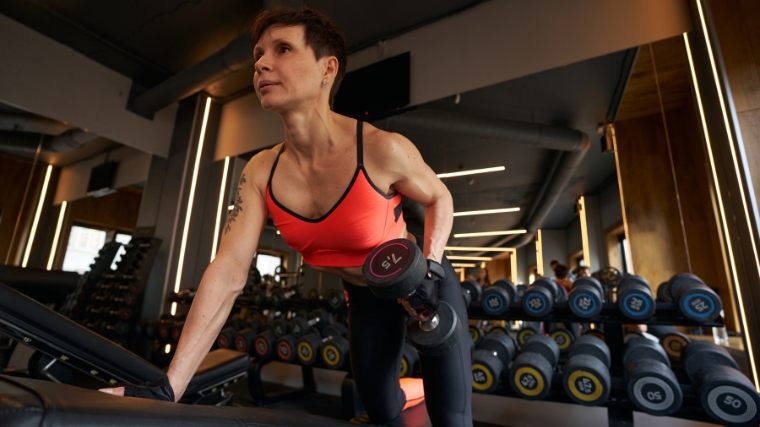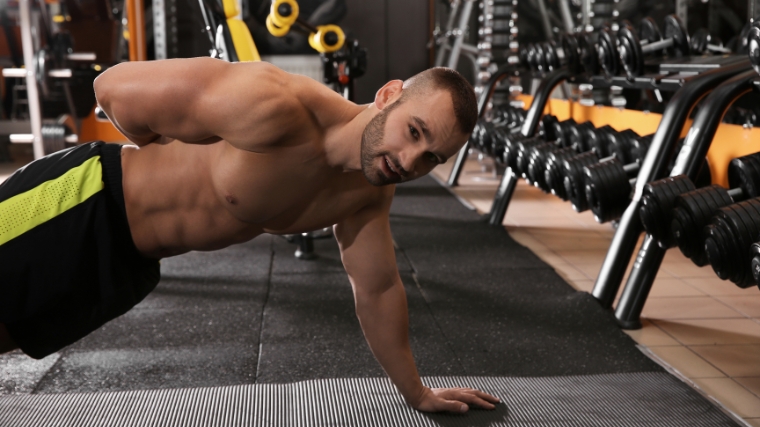The last time you fought through a heavy bench press, you might have noticed one side of your body fighting harder than the other to lock out. That precarious tilt of the barbell is a prime indicator of a strength imbalance. A difference in lockout strength can also be caused by a muscle size imbalance, which is a big no-no for bodybuilders.
Unilateral training — or training that mainly involves focusing on one limb — may help you even out your imbalances. Working one side at a time can also improve your core strength and balance while potentially helping prevent injuries. It can aid athletes with sports performance on the field and even improve bilateral strength on the platform.
But if you’re after maximum strength with a barbell, is it worth throwing a single-arm dumbbell bench press into your program? Read on to find out everything you need to know about unilateral training — including whether it can fix muscular and strength imbalances.
- What Is Unilateral Training?
- Benefits Of Unilateral Training
- Does Unilateral Training Fix Imbalances?
- Who Should Train Unilaterally
Editor’s Note: The content on BarBend is meant to be informative in nature, but it should not be taken as medical advice. When starting a new training regimen and/or diet, it is always a good idea to consult with a trusted medical professional. We are not a medical resource. The opinions and articles on this site are not intended for use as diagnosis, prevention, and/or treatment of health problems. They are not substitutes for consulting a qualified medical professional.
What Is Unilateral Training?
A unilateral exercise is a weight-bearing movement mainly or completely involving one limb at a time. Think: single-arm and single-leg exercises. Bilateral exercises, like barbell squats and barbell deadlifts, in contrast, distribute the weight evenly and simultaneously across both limbs. (1)
Unilateral exercises might involve you performing all your reps with one limb at a time, such as a Bulgarian split squat which emphasizes the front leg throughout the entire set. Then, you perform the same amount of reps with your legs switched. Other unilateral exercises, like walking lunges, alternate between sides with each rep.
Still other unilateral exercises — performed with dumbbells or kettlebells, which are designed to be comfortably manipulated with one hand — are left for you to decide. You can perform hammer curls simultaneously with both arms, for example. Or, you can alternate.
If you choose, you can also do all your reps with your left arm, then all your reps with your right arm. This last configuration gives the “truest” form of unilateral training, where one limb is truly being emphasized with each rep throughout the entire set.
Unilateral Training Vs. Bilateral Training
When comparing unilateral and bilateral training, you might first turn to the principle of specificity. That is, to achieve a specific goal, you need to train in a specific way. For example, to get better at squatting, you need to squat. Therefore, it makes sense that unilateral resistance training can improve unilateral performance better than bilateral training, and vice versa. (1)
But that doesn’t make unilateral training worthless if your main lifts — barbell lifts — happen bilaterally.
Take that squat example again. Yes, you need to squat to get better at squatting. But to really maximize your gains, you also need to improve your hip and ankle mobility. If your quads start to become a weak point in your squat, build up your quads specifically to assist. You get the idea — assistance exercises can dramatically improve main exercises.
That’s where unilateral training comes into play. For some people, a unilateral exercise is a goal unto itself — your goal might well be to conquer a single-leg squat or a single-arm pull-up. But if your goal is more general (like developing a stronger barbell deadlift), unilateral training can still be tremendously beneficial.
Let’s look at a few key concepts that make unilateral training so enticing: cross-education and the bilateral deficit.
Cross-Education
Cross-education (CE) describes the phenomenon of gaining strength in your untrained limb after lifting unilaterally. (2)(3)(4)(5) The term cross-education dates back to 1894 and has been repeatedly illustrated in studies since then. (2)
Some research proposes that unilateral muscular contractions can have a strong, immediate effect on the neural elements controlling the opposite limb. (2)(5) Other evidence suggests that the temporal lobe in the brain may be more impactful at creating cross-education than motor learning. (6)
Regardless of the precise mechanisms at play, cross-education seems to make unilateral training effective at strengthening both limbs. Still, an objection may arise. Athletes might worry that keeping the rep scheme the same on both sides won’t help even out imbalances. After all, if your right side is stronger, shouldn’t you do more reps on your left side to compensate?
Rest (or, rep) assured. Research suggests that cross-education doesn’t work both ways. Unilateral strength increases seem to flow from your dominant side to your nondominant side — but not necessarily the other way around. (7)
So if you’re right-handed, training unilaterally may help give additional strength to your left side. But training unilaterally with your nondominant left hand may not make your right side even stronger. (7)
Bilateral Deficit
Sometimes, you’re not sure if your left arm does pop up faster than your right arm during your bench press. And if it does, maybe you’re the only one who’s uniquely bad at performing an even-handed barbell press. Well, science suggests that you’re not.
The bilateral deficit (BLD) is a phenomenon that shows a reduced force output from one limb during a bilateral movement — like a max effort barbell bench press. (8) In some exercises, this might translate into being able to lift more unilaterally (one limb at a time) than bilaterally (both limbs together). (9)
This shows how potentially detrimental it can be to have one limb generate less force than the other on your bilateral lifts. With uneven force output, you might be able to lift less bilaterally. By strengthening both respective limbs, you might be able to raise the bar for your performance with bilateral lifts.
Upper Body Unilateral Exercises
If you’re ready to start cross-educating your body, let’s start training unilaterally.
Here are some examples of upper-body unilateral exercises for vertical and horizontal pushing and pulling movement patterns, as well as core stabilization.
- Single-Arm Overhead Press (Dumbbell or Kettlebell)
- Single-Arm Cable Pulldown
- Single-Arm Pull Up
- Single-Arm Push Up
- Single-Arm Bench Press (Dumbbell or Kettlebell)
- Single-Arm Row (Cable, Dumbbell, Kettlebell, or TRX)
- Single-Arm Farmer’s Carry
- Side Plank
Lower Body Unilateral Exercises
Here are some examples of lower-body unilateral exercises for hip-dominant and knee-dominant movement patterns. You can start these as bodyweight exercises, and progress using a dumbbell or kettlebell where appropriate.
- Single-Leg Glute Bridge
- Single-Leg Hip Thrust
- Single-Leg Deadlift
- Single-Leg Jump
- Pistol Squat
- Step-Up
- Split Squat
- Bulgarian Split Squat
- Reverse Lunge
- Walking Lunge
- Forward Lunge
- Lateral Lunge
Benefits of Unilateral Training
When designing your training program, you want to choose the most effective movements to fit your goals and experience level. Here are some of the reasons that unilateral exercises deserve to make the cut.
Combat Strength and Muscle Imbalances
Working one side of your body at a time may help to correct strength and muscular imbalances. With the bench press, if the left side of the bar is consistently lagging, there are several reasons it may be happening. There could be less strength or muscle in your left pec, triceps, or rotator cuff muscles.
It could also be an issue of stability or mobility. Taking the time to address the mobility, stability, strength, and muscle of your left side can help to improve your bench press performance. These factors can also help reduce the risk of overusing your right side or compensating with other joints or muscles.
That doesn’t mean you’ll be neglecting your dominant side. Training your dominant side unilaterally may also increase the strength of your weaker side. (2) Try adding a training block into your program to work with the single-arm dumbbell bench press, for example.
Enhance Core Strength and Stability
Whether you’re a physique athlete or not, having a strong core is essential for stabilizing and protecting your spine. Unilateral exercises challenge your balance to keep you from tilting this way and that. Plus, you’ll have to keep your torso still while your limbs work separately, which means your core needs to work overtime.
In a lower body exercise like a squat, having one less leg on the ground for a pistol squat changes your base of support and takes away stability. You may feel your core automatically engage to fight to stay standing. With a single-arm overhead press, your core will fire up to keep your shoulders and hips squared.
One study on cisgender women basketball players showed that trunk stability increased after eight weeks of unilateral core training. (10) In basketball and other sports, rotational stability while moving the limbs around is important to prevent injury. In this way, unilateral exercises in your cross-training program can help your longevity as an athlete. (10)
Improve Balance
In addition to working your core to help you stay balanced, unilateral training may improve your balance overall. This may be especially true for older adults. (9)
As people age, BLD has been shown to increase, making them less balanced. (6) A study was also done on younger adults (between ages 20 and 30) and older adults (over age 65) to see if unilateral exercises could help decrease their BLD over time. (6)
Balance training was done using unilateral exercises on uneven surfaces like wobble boards and soft mats. (6) At the end of the 13-week study, the older adults showed a decrease in BLD, bringing them closer to the BLD levels of the younger adults in the study. (6)
If you’re an older athlete or you’re just aiming to promote your longevity on the lifting platform, unilateral training might be a great way to fight off increasing imbalances as you age.
But this balance isn’t only important as you age. It’s also a fundamental part of supporting powerful lifts. The more balanced you are during bilateral lifts, the more stable your base of support will be. Along with this will come a more efficient transfer of force from the ground through the lockout of your lift. The better you transfer force, the heavier you can lift.
May Aid in Injury Prevention and Rehabilitation
Unilaterally training your limbs may help prevent injury in the long term. For example, you may repeatedly push through an uneven squat by tilting to a weaker side. It’s possible to form injuries due to overcompensation in your hips, knees, ankles, lower back, or other muscles. Similar injuries from overcompensation are possible with other lifts.
Strengthening the weaker side can help you push evenly through both sides in your bilateral movements, potentially preventing injury on either side during training.
[Read More: The Best Ab Exercises & Workouts, According to a CPT]
That’s one reason that people rehabilitating from injuries are often given unilateral exercises in physical therapy. Unilateral work continues strengthening the uninjured side while progressively rebuilding strength on the recovering side.
Even while injured, studies show that due to cross-education, training the uninjured side can help to preserve strength and size in the injured and immobilized opposite side. (7) So if a doctor clears you to do so, you might find a lot of benefits from training with your right arm only even if your left arm is in a cast. (7)
Boost Sports Performance
It’s not all about the lifting platform. If you’re a sprinter or jumper or if you play baseball, football, soccer, or basketball, unilateral training has been repeatedly shown to improve sports performance.
Most soccer players, for example, favor one leg over the other. Adding unilateral strength exercises to a sports-specific training regimen can improve muscular deficits. (8) In this way, strength training can help athletes prevent overcompensation patterns that can negatively impact their joint health and long-term potential in their sport. (8)
Increase Bilateral Strength
According to the principle of specificity, if you want to increase your bilateral strength, you should train bilaterally. (1) Plus, you can lift heavier in less time in a bilateral deadlift than a single-leg deadlift, for example. If you’re limited on time at the gym, bilateral exercises may be the way to go.
But training unilaterally will likely carry over to improve your bilateral strength in the long term. Training unilateral presses allows you to lift more on each side over time, and by ironing out and preventing imbalances, you’re keeping yourself healthy and training longer.
Does Unilateral Training Fix Imbalances?
Unilateral training is often credited with fixing imbalances. And while more studies are needed on the direct restoration of muscular balance after imbalances have developed, the evidence seems to suggest that unilateral exercises can play a role here. (9)
Strength Imbalances
If you’re developing a strength imbalance, or have developed one while injured, it seems that unilateral exercises can help. Immobilization over three to four weeks will lead to an expected decline in strength. But research suggests that unilateral training of the unaffected limb can stop these expected declines in strength and muscle in the immobilized limb. (12)
[Read More: The Most Effective Workout Splits, Created by Our Experts]
Still, it’s complicated. These specific effects have only been noted in a clinical setting, and there has only been one randomized trial that uses CE in addition to standard medical treatment. (12) More research can help shed light on the most effective ways to integrate unilateral training if you’re searching for ways to even out existing strength imbalances.
Muscle Size Imbalances
Unilateral training might be able to save your muscles (called muscle sparing) on the contralateral (nonworking) side. (12)
One study compared the effectiveness of different training modes — including unilateral training — in altering shoulder strength ratios. This study was done to benefit athletes like pitchers and tennis players, who are at risk for overusing their dominant shoulder in their sport. (11)
Results showed that all exercise types — not solely unilateral exercises — may be effective in restoring muscle size imbalances in the rotator cuff. (11) Isokinetic training was shown to be the most effective. Since isokinetic training requires a machine in a clinical setting, the study suggests MJDR (multi-joint dynamic resistance) training is the next best option.
Some examples of multi-joint dynamic resistance exercises in the study included unilateral pull-ups, lat pulldowns, overhead presses, and push-ups. (11) Performing these exercises bilaterally and unilaterally was effective at reducing muscle size imbalance.
Who Should Train Unilaterally
Wondering if unilateral training is for you? Let’s look at the populations that may benefit most.
People Recovering From Injuries
If you’re recovering from an injury, unilateral training can help gradually build your strength back. Some single-joint exercises can be done without bearing weight — like lunges — so you might want to opt for bodyweight-only versions before adding external load. Always consult with a doctor or qualified physical therapist first.
Unilateral training during an injury may also help preserve strength and muscle on the injured side. So if you broke your right wrist but love pull-ups, you can start training single-arm pull-ups — use a resistance band for assistance — while you wait to fully recover. Again, do this with the express approval of a licensed medical professional.
Older Adults
Balance is important for athletes of all ages, including older adults. Balance exercises have been shown to reduce the chances of falling or other injuries. (13) In a study on postmenopausal people, unilateral training was shown to help increase lower body lean tissue mass. (9)
Unilateral training doesn’t have to mean a 100-pound pistol squat or single-arm pull-up. Simply standing on one leg while engaging your core and standing tall can function as an isometric, unilateral exercise that will improve balance. You can progress by holding a ball or drawing the non-standing leg up towards your chest to engage your hip flexor.
Bodybuilders
Muscle size imbalances are often noticeable to physique athletes, whose competition style centers not around the amount of weight lifted, but on the aesthetic being presented. For competitive bodybuilders, symmetry is paramount. Unilateral training is key to crafting this symmetry.
While bodybuilders focus on slow, eccentric movements, they may want to utilize unilateral training to get greater gains. On stage or not, anyone focusing on hypertrophy can benefit from unilateral exercises to lift a little heavier and build more muscle.
Strength Athletes
From strength athletes who compete on a platform to athletes to compete on a field, unilateral training can have immense impacts on performance quality.
The majority of research, studies, and evidence on the benefits of unilateral training are focused on athletes. Playing sports makes intense, somewhat unpredictable demands on your body. The improved balance that comes with unilateral training is an essential part of making you a resilient, effective athlete.
[Read More: The Best Bodyweight Exercises, + Workouts and Tips From a CPT]
For lifters, too, you’ll want unilateral exercises in your repertoire because they’ll help support your main bilateral lifts. By ironing out any side-to-side weaknesses, you can help yourself achieve safer, more stable lifting mechanics. Ultimately, this can translate into better force transfer and heavier lifts.
A Delicate Balance
Unilateral exercises may not be as glamorous as their big bilateral cousins. Barbells seem to be what so many athletes gravitate toward. But don’t count out classic unilateral implements like dumbbells, kettlebells, and cables.
With unilateral training, you’ll strengthen both sides of your body — even if one side is injured — and may be able to combat the kinds of overcompensations that can lead to injury. All of that can carry over into heavier, more powerful lifts.
More research is needed on more genders, age groups, and strength athletes whose main sport is lifting. But unilateral training carries a lot of weight. Don’t leave one side of your bar straggling behind — consider giving it some unilateral care.
References
- Liao KF, Nassis GP, Bishop C, Yang W, Bian C, Li YM. Effects of unilateral vs. bilateral resistance training interventions on measures of strength, jump, linear and change of direction speed: a systematic review and meta-analysis. Biol Sport. 2022 Sep;39(3):485-497.
- Lee M, Carroll TJ. Cross education: possible mechanisms for the contralateral effects of unilateral resistance training. Sports Med. 2007;37(1):1-14.
- Martínez F, Abián P, Jiménez F, Abián-Vicén J. Effects of Cross-Education After 6 Weeks of Eccentric Single-Leg Decline Squats Performed With Different Execution Times: A Randomized Controlled Trial. Sports Health. 2021 Nov-Dec;13(6):594-605.
- Carr JC, Ye X, Stock MS, Bemben MG, DeFreitas JM. The time course of cross-education during short-term isometric strength training. Eur J Appl Physiol. 2019 Jun;119(6):1395-1407.
- Green LA, Gabriel DA. The cross education of strength and skill following unilateral strength training in the upper and lower limbs. J Neurophysiol. 2018 Aug 1;120(2):468-479.
- Farthing JP, Borowsky R, Chilibeck PD, Binsted G, Sarty GE. Neuro-physiological adaptations associated with cross-education of strength. Brain Topogr. 2007 Winter;20(2):77-88.
- Farthing JP, Chilibeck PD, Binsted G. Cross-education of arm muscular strength is unidirectional in right-handed individuals. Med Sci Sports Exerc. 2005 Sep;37(9):1594-600.
- Škarabot J, Cronin N, Strojnik V, Avela J. Bilateral deficit in maximal force production. Eur J Appl Physiol. 2016 Dec;116(11-12):2057-2084.
- Janzen CL, Chilibeck PD, Davison KS. The effect of unilateral and bilateral strength training on the bilateral deficit and lean tissue mass in post-menopausal women. Eur J Appl Physiol. 2006 Jun;97(3):253-60.
- Kim Y, Kim J, Yoon B. Intensive unilateral core training improves trunk stability without preference for trunk left or right rotation. J Back Musculoskelet Rehabil. 2015;28(1):191-6.
- Malliou PC, Giannakopoulos K, Beneka AG, Gioftsidou A, Godolias G. Effective ways of restoring muscular imbalances of the rotator cuff muscle group: a comparative study of various training methods. Br J Sports Med. 2004 Dec;38(6):766-72.
- Andrushko JW, Gould LA, Farthing JP. Contralateral effects of unilateral training: sparing of muscle strength and size after immobilization. Appl Physiol Nutr Metab. 2018 Nov;43(11):1131-1139.
- Thomas E, Battaglia G, Patti A, Brusa J, Leonardi V, Palma A, Bellafiore M. Physical activity programs for balance and fall prevention in elderly: A systematic review. Medicine (Baltimore). 2019 Jul;98(27):e16218.
Featured Image: Nikolas_jkd / Shutterstock
